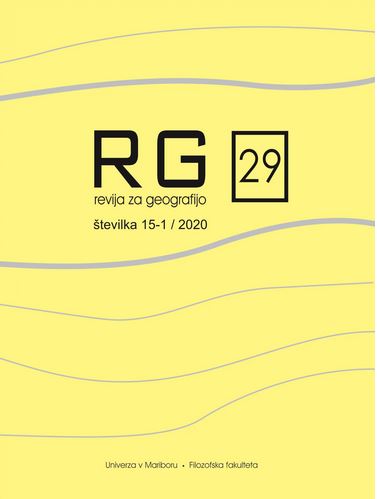Landscape dynamics triggered by different economic systems: an example of LANDSAT satellite data applicability
DOI:
https://doi.org/10.18690/rg.15.1.3624Keywords:
CVA, Goričko-Raab-Örség, LANDSAT, PCA, landscape change, spectral changeAbstract
Ensuring sufficient productivity growth is central to economic development. However, these process leaves behind characteristic environmental footprints which differ between economic systems driven by different political ideologies. To assess such landscape-level political-economic impacts, a homogeneous cultural landscape, shared by countries with different land use management systems, must be studied. The Trilateral Park Goričko-Raab-Örség represents an ideal investigation polygon for such research questions. In this paper, the time-sequences of LANDSAT satellite multi-spectral imagery were applied to calculate landscape change dynamics represented with spectral change magnitude and direction variables. The results show significant differences in both indicators, between countries (or political-economic systems) and between studied time intervals (1984-1992, 1992-2007, 2007-2020), despite the fact that, after the collapse of socialism in Yugoslavia and real-socialism in Hungary, there were no radical changes in land use or parcel ownership. Our findings have an addition value, since such an objective methodological approach can be practically transferred to all politically marginal areas that share a homogeneous cultural landscape and leave behind different spatial footprints.
Downloads
References
Bičík, I., Jeleček, L. in Štěpánek, V., 2001: Land-use changes and their social driving forces in Czechia in the 19th and 20th centuries. Land Use Policy, 65-73.
Bürgi, M., Hersperger, A. M. in Schneeberger, N., 2004: Driving forces of landscape change current and new directions. Landscape Ecology, 857-868.
Cousins, S. A., Kaligarič, M., Bakan, B. in Regina, L., 2014: Political Systems Affect Mobile and Sessile Species Diversity–A Legacy from the Post-WWII Period. PLoS ONE, 1-7.
Dinno A., 2017: Dun.test: dunn's test of multiple comparisons using rank sums. R package version 1.3.5.
Donald, P. F., Sanderson, F. J., Burfield, I. J. in Van Bommel, F. P., 2006: Further evidence of continent-wide impacts of agricultural intensification on European farmland birds, 1990-2000. Agriculture, Ecosystems and Environment, 116(3-4),189-196.
Eastman, J., 2020: TerrSet. Clark Labs-Clark University.
Fox J. in Bouchet-Valat M., 2020: Rcmdr: R Commander. R package version 2.7-1.
Geiger, F., Bengtsson, J., Berendse, F., Weisser, W. W., Emmerson, M., Morales, M. B. s sod., 2010: Persistent negative effects of pesticides on biodiversity and biological control potential on European farmland. Basic and Applied Ecology, 1(2), 97-105.
Gobster, P. H., Nassauer, J. I., Daniel, T. C. in Fry, G., 2007: The shared landscape: what does aesthetics have to do with ecology?. Landscape ecology, 22(7), 959- 972.
Hansen, A. J., Defries, R. in Turner, W., 2004: Land Use Change and Biodiversity: A Synthesis of Rates and Consequences during the Period of Satellite Imagery. Land Change Science: Observing, Monitoring, and Understanding Trajectories of Change on the Earth's Surface, 277-299.
Herzog, F., Steiner, B., Bailey, D., Baudry, J., Billeter, R., Bukácek, R. s sod., 2006: Assessing the intensity of temperate European agriculture at the landscape scale. European Journal of Agronomy, 24(2), 165-181.
Mander, Ü. in Jongman, R. H., 1998: Human impact on rural landscapes in central and northern Europe. Landscape and Urban Planning, 149-153.
Meyer, D., Zeileis, A. in Hornik, K., 2020: VCD: Visualizing Categorical Data. R package version 1.4-8.
Navarro, L. M. in Pereira, H. M., 2012: Rewilding Abandoned Landscapes in Europe. Ecosystems 15, 900-912.
Newbold, T., Hudson, L. N., Arnell, A. P., Contu, S., De Palma, A., Ferrier, S. s sod., 2016: Has land use pushed terrestrial biodiversity beyond the planetary boundary? A global assessment. Science, 288-291.
Ogle DH., Wheeler P, Dinno A., 2020: FSA: Fisheries Stock Analysis. R package version 0.8.30.
Peña, J., Bonet, A., Bellot, J., Sánchez, J. R., Eisenhuth, D., Hallett, S. in Aledo, A., 2007: Driving forces of land-use change in a cultural landscape of Spain. In Modelling land-use change, 97-116.
Plieninger, T., Draux, H., Fagerholm, N., Bieling, C., Bürgi, M., Kizos, T. s sod., 2016: The driving forces of landscape change in Europe: A systematic review of the evidence. Land Use Policy, 204-214.
Primdahl, J. in Swaffield, S. 2010. Globalisation and Agricultural Landscapes: Change Patterns and Policy Trends in Developed Countries. Cambridge: Cambridge University Press.
R Core Team, 2018: R: A language and environment for statistical computing. R Foundation for Statistical Computing, Vienna, Austria.
Seidl, R., Thom, D., Kautz, M., Martin-Benito, D., Peltoniemi, M., Vacchiano, G. s sod., 2017: Forest disturbances under climate change. Nature climate change, 7(6), 395-402.
Skokanová, H., Falťan, V. in Havlíček, M., 2016: Driving forces of main landscape change processes from past 200 years in Central Europe - differences between old democratic and post-socialist countries. Ekológia (Bratislava), 50-56.
Stoate, C., Báldi, A., Beja, P., Boatman, N. D., Herzon, I., Van Doorn A. in Ramwell, C., 2009: Ecological impacts of early 21st century agricultural change in Europe– a review. Journal of environmental management, 91(1), 22-46.
Theurillat, J. P., in Guisan, A., 2001: Potential impact of climate change on vegetation in the European Alps: a review. Climatic change, 50(1-2), 77-109.
Medmrežje1: https://ec.europa.eu/info/food-farming-fisheries/key- policies/common-agricultural-policy/future-cap/key-policy-objectives-future- cap_en#nineobjectives (10.10.2020).
Medmrežje 2: https://earthexplorer.usgs.gov/ (20.8.2020).
Medmrežje 3: https://ec.europa.eu/eurostat/data/database (18.8.2020).
Medmrežje 4: https://land.copernicus.eu/pan-european/corine-land-cover (14.8.2020).
Downloads
Published
Issue
Section
License
Copyright (c) 2020 Daša Donša

This work is licensed under a Creative Commons Attribution 4.0 International License.
